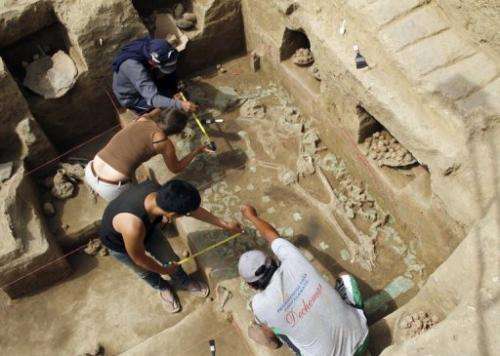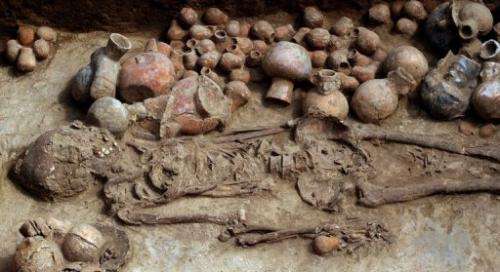Tomb find confirms powerful women ruled Peru long ago

The discovery in Peru of another tomb belonging to a pre-Hispanic priestess, the eighth in more than two decades, confirms that powerful women ruled this region 1,200 years ago, archeologists said.
The remains of the woman from the Moche—or Mochica—civilization were discovered in late July in an area called La Libertad in the country's northern Chepan province.
It is one of several finds in this region that have amazed scientists. In 2006, researchers came across the famous "Lady of Cao"—who died about 1,700 years ago and is seen as one of the first female rulers in Peru.
"This find makes it clear that women didn't just run rituals in this area but governed here and were queens of Mochica society," project director Luis Jaime Castillo told AFP.
"It is the eighth priestess to be discovered," he added. "Our excavations have only turned up tombs with women, never men."
The priestess was in an "impressive 1,200-year-old burial chamber" the archeologist said, pointing out that the Mochica were known as master craftsmen.
"The burial chamber of the priestess is 'L'-shaped and made of clay, covered with copper plates in the form of waves and sea birds," Castillo said.
Near the neck is a mask and a knife, he added.

The tomb, decorated with pictures in red and yellow, also has ceramic offerings—mostly small vases—hidden in about 10 niches on the side.
"Accompanying the priestess are bodies of five children, two of them babies, and two adults, all of whom were sacrificed," Castillo said, noting there were two feathers atop the coffin.
Julio Saldana, the archeologist responsible for work in the burial chamber, said the discovery of the tomb confirms the village of San Jose de Moro is a cemetery of the Mochica elite, with the most impressive tombs belonging to women.
© 2013 AFP

















